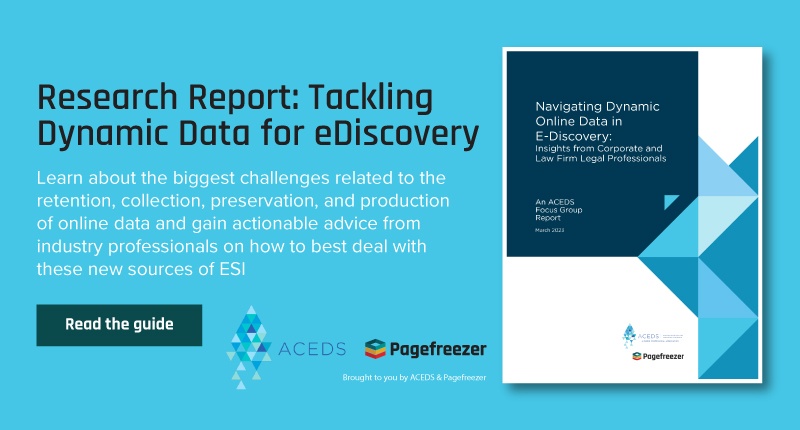To shed light on the impact of managing of dynamic electronically stored information (ESI) on legal and compliance processes, Pagefreezer hosted a webinar featuring Mike Quartararo from ACEDS (Association of Certified E-Discovery Specialists), Michael Simon from Seventh Samurai Legal Consulting, and Peter Callaghan from Pagefreezer.
This article will cover the key takeaways from the webinar and highlights expert tips for improving the management of dynamic ESI for eDiscovery and litigation readiness.
Defining Dynamic ESI
Before diving into our experts' analysis, let's first define the term “dynamic ESI”. Dynamic ESI refers modern online data that is constantly evolving — some characteristics include:
- Mixed content types (text, images, GIFs, videos, attachments, etc.)
- Real-time activity — elements like comments are constantly added, edited, and deleted
- Electronically stored information that remains in a cloud-based environment, owned by a 3rd party
Today, where digital communications reigns supreme, these data sets are seamlessly stored, shared, and accessed through various software platforms. The omnipresence of dynamic ESI is inescapable.
Pretty much any information that isn’t in physical form is considered electronically stored information. ESI is why the term ‘eDiscovery’ exists — without it, legal discovery would exclusively deal with paper and physical documentation.
ESI is considered dynamic if it is changes consistently or is iterated upon based on activity or engagement. For example, these ESI sources possess this dynamic quality:
- Websites
- Social media platforms (Facebook, Instagram, X, LinkedIn)
- Video marketing apps (YouTube)
- Enterprise collaboration tools (Slack, MS Teams, Workplace by Meta)
- Chat applications (WhatsApp, WeChat)
- Text messages
- Sound recordings & voicemails
- Data from smart devices (doorbells, smart watches, smart appliances, etc.)
- Database information
- Electronically shared files & word processing documents
Key Insights on How Organizations Manage Dynamic ESI
During the webinar, our experts referenced research from a partnership between Pagefreezer and ACEDS. You can access the full report here.
The research and analysis involved two focus groups of in-house legal professionals and law firm representatives, along with a subsequent survey, to gain insights into how organizations manage dynamic ESI for eDiscovery projects.
The research revealed key challenges faced by the legal community that our experts then weighed-in on during the webinar:
1) There is a Major Shift in Communication Channels
The adoption of remote work and increased the reliance on online collaboration tools as accelerated. Applications like Slack and Microsoft Teams have become essential for informal communication within organizations, often replacing traditional email channels. This shift is forcing eDiscovery professionals to once again redefine what constitutes a document, or, taking it one step further:
"It's time to leave behind the concepts of documents. We're no longer dealing with documents; we're dealing with extensions of systems [like OneDrive, MS Teams, Slack, Google Drive, SharePoint, etc.]." - Michael Simon
2) Challenges of Identifying and Collecting Website Data
Website data has become much more common in legal matters, particularly in cases involving misleading product claims. The audience poll in the webinar also indicated that a significant portion found it somewhat or very difficult to identify, preserve, and collect website data for legal matters.
"We're seeing more litigation around websites and the promises made on websites. It could be a challenge for organizations to handle this data effectively." —Mike Quartararo
3) Shifting Notions of Scope and Data Preservation
The speakers emphasized the need to update perspectives on the scope of discovery. Collaboration apps, personal devices, and other dynamic data sources should be considered discoverable. They also stressed the importance of preserving data properly to maintain its integrity for potential legal proceedings.
"Anything that's relevant to a legal matter, investigation, or regulatory inquiry can be considered in scope. We need to help people understand what could potentially be in scope." —Peter Callaghan
4) The Raising Importance of Data Policies
With the continuous growth of data generation, the importance of data retention policies becomes even more critical. Various factors come into play when determining these policies, and eDiscovery is just one of them.
Michael Simon highlights the historical challenges faced in promoting information governance, but the landscape has drastically changed due to concerns surrounding cybersecurity, data leakage, and privacy.
While organizations now understand the urgency of managing data and minimizing unnecessary collection to safeguard sensitive information, their biggest obstacle in managing data volume is the lack of clarity in defining which data to retain and which to dispose of, as well as enforcing such policies.
"People aren't incentivized to get rid of things, but with cybersecurity and privacy concerns, information governance has taken center stage." —Michael Simon
5) Exploding Data Volumes
The volume of dynamic online data has been rapidly growing, driven by the proliferation of digital communication channels and remote collaboration. The research revealed a consensus among respondents that data volumes have increased significantly in the past year. Here’s what Michael Simon shared when asked about the increase in data volume in relation to most e-Discovery projects:
"Yeah. It’s only increasing, and it’s never going back. This is not a wave, folks. Waves recede. This is the new high water line." —Michael Simon
Expert Tips: Managing Information Governance for eDiscovery
Managing vast volumes of data while ensuring compliance with legal and regulatory requirements has been a daunting task for organizations. The dynamic nature of various technologies and the proliferation of data across various platforms present new challenges in information governance.
“The volume is what the volume is. We don't think that's going to change, but what you can do as an organization to help yourself is to really understand what data you have, where you have it, how you can get to it, and how you can manage it in a way that keeps you out of trouble.” —Mike Quartararo
Here's are some tips our experts shared on how organizations can set themselves up for more streamlined processes in eDiscovery and ESI management:
1. Improve Relationships with Records and IT Management:
Collaboration among different teams, including legal, records management, and IT, is crucial for effective data management. The panelists emphasized the need to work closely with these stakeholders to develop clear policies, consolidate platforms, and establish robust data management practices. This collaboration ensures a shared understanding of data management objectives and facilitates smoother implementation.
2. Develop Clear Retention Policies
To navigate the complexities of data preservation and collection, organizations must develop specific retention policies. These policies outline how long data should be retained, what types of data should be retained, and any legal obligations associated with data retention. By having well-defined retention policies, organizations can streamline their data management processes and avoid unnecessary accumulation of data.
3. Provide Training and Ongoing Education
Continuous education and training programs play a crucial role in enhancing data management practices. By raising awareness of legal obligations, privacy considerations, and proper collaboration tool usage, organizations can equip their staff with the knowledge necessary to navigate data management challenges. Training programs should be tailored to different roles and regularly updated to keep pace with evolving data management trends.
Streamlining eDiscovery starts with a proactive and strategic approach to information governance, which often falls outside of the purview of a legal team. However, this shouldn’t deter eDiscovery professionals from influencing policies, facilitating stronger communications and collaboration amongst teams, and providing continuous education on data management from a legal perspective.
Dynamic ESI: Leveraging Technology for e-Discovery
As organizations navigate the complexities of eDiscovery in this era of data volume and data source growth, legal professionals can also leverage specialized tools to help them identify, preserve, collect, and review this data efficiently.
It should be noted that not all eDiscovery products are created equal — the best solutions will create a database of saved records that retain the native look and feel of the original data source, as well as the context and relationships of the data and users so that legal teams can easily reconstruct conversations and threads.
Comprehensive solutions are designed to address the challenges posed by high volumes of dynamic data from a variety of sources. Here's what to look for in your ESI capture and retention technology:
- Wide capture covering a variety of ESI: The ability to capture and archive data from various sources, including websites, social media platforms, collaboration tools, instant messaging apps, and more.
- Real-time capture: Automatic capture and retention of data as it is generated or updated, ensuring that no critical information is missed.
- Comprehensive archiving: Securely stored archived data in compliance with industry standards and regulations, such as WORM (Write Once, Read Many) technology and legal admissibility standards, ensuring the integrity, authenticity, and tamper-proofing of captured data.
- Advanced search and retrieval: An intuitive interface and advanced search functionality that allows users to quickly locate and access specific information across all archives, accounts, direct conversations, timelines, and groups.
- Easy legal holds: The ability to place users and data on legal hold to prevent the deletion of crucial evidence.
- Preservation of metadata: Capture and preservation of the metadata of dynamic ESI, including timestamps, user information, and other contextual details. Records should be time-stamped and signed with a SHA-256 digital signature.
- In-context review: All data presented in original context and the ability to select relevant content, add comments, and export files to local servers for eDiscovery purposes.









